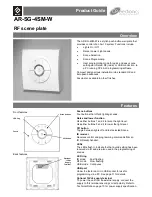
Appendix A: The Chilled Water System Optimizer — Status only view of the Properties page
Chilled Water System Optimizer v2
CARRIER CORPORATION ©2019
Installation and Start-up Guide
51
All rights reserved
Point Name/Description
4. AND are outdoor air conditions met? —
Set the outside air temperature enable conditions to stabilize the program when
the weather is warm enough for the chiller plant to stabilize. - Displays YES or NO status.
__ degrees — Outdoor Air Temperature
— Displays current OAT
5. AND are Part Load Conditions met? —
Set the part load conditions to fit your chiller plant. The program defaults to run
when the chiller plant is operating above 20%.
If the reset is applied at very low load conditions, the plant may cycle off more frequently when on low load or low delta
temperature. The program starts to cool down to lowest chilled water supply temperature when the load is below the low
threshold. - Displays YES or NO status.
_.___%
Current load/capacity
— Displays value.
6. AND is the Chilled Water Temperature Difference (return-supply) across the chiller evaporator great enough? —
Set a
minimum allowed temperature across the evaporator so the temperature difference will not drop too low. This prevents the
chiller from cycling off on low load too often and helps to stabilize chiller operation. The optimization program will not start
until the temperature drop across the evaporator is large enough. - Displays YES or NO status.
Chilled Water Temperature Difference
— Displays delta temperature in degrees
Loss of Communications Lockout Conditions
Loss of Network Communications Conditions
Optimizer __
latched off due to comm loss
— Displays status.
Time since loss of comm _:__ (mm:ss)
— Displays status.
Number of comm losses this period __
— Displays value.
Time since first loss of comm _:__ (mm:ss)
— Displays value.
Alarm(s
):
COMMLOSS (BALM) Loss of Comm Alarm
— Displays Off/On communication alarm status.
SENSOR
(BALM)
__ Sensor Out of Range
— Displays Off/On status.
Section 2 - Chiller System Power, Efficiency, and Thermal Load Input
Status
Navigation:
i-Vu®
Properties
>
Control Program
>
General Conditions & Status
>
Section 2 - Chiller
System Power, Efficiency and Thermal Load Input Status
Verify network connections are operating. See
Device Address Binding
(page 45).
Input the nominal chiller capacities (tons) required to determine part load conditions.
Select whether the power input is actual kW or amperage.
Select load input type using temperatures and flow or cooling load input.
















































